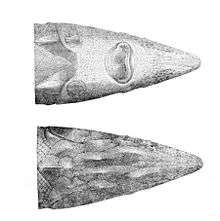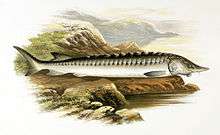European sea sturgeon
The European sturgeon (Acipenser sturio), also known as the Atlantic sturgeon or common sturgeon, is a species of sturgeon previously found on most coasts of Europe. It is anadromous and breeds in rivers. It is currently a critically endangered species.[1] Although the name Baltic sturgeon sometimes has been used, it has now been established that sturgeon of the Baltic region are A. oxyrinchus, a species otherwise restricted to the Atlantic coast of North America.[4]


| European sturgeon | |
|---|---|
 | |
| Acipenser sturio | |
| Scientific classification | |
| Kingdom: | |
| Phylum: | |
| Class: | |
| Order: | |
| Family: | |
| Genus: | |
| Species: | A. sturio |
| Binomial name | |
| Acipenser sturio | |
| Synonyms[2][3] | |
|
List
| |
The wedge-shaped head of the European sea sturgeon ends in a long point. There are many sensitive barbels on the facial area. The dorsal fins are located very far back on the body. Five longitudinal lines of large osseous plates are found on the body of the fish. The stomach is yellow and the back is a brownish grey.
This sturgeon can reach 6 m (20 ft) and 400 kg (880 lb) in weight, but a more common length is 1.25 m (4 ft 1 in).[5] They can reach an age of 100 years,[5] and have a late sexual maturity (12 to 14 years for the males and 16 to 18 years for the females).
They are found on the coasts of Europe, except in the northernmost regions and the Baltic region, and have rarely even been known to cross the Atlantic Ocean to the coasts of North America. Like many other sturgeons, they spawn in the rivers inland from the coast. Despite their estimated range of distribution, they have become so rare that they only breed in the Garonne river basin in France. Conservation projects involving this species include reintroductions based on specimens from aquaculture with the first releases in 1995.[1] For example, 87 sturgeons were experimentally released in the Rhine near Nijmegen in 2012 and 2015 .
Like other sturgeons, they eat mollusks and crustaceans which they find with their barbels.
At the beginning of the 19th century, these fish were used extensively to produce caviar, but have been a protected species in Europe since 1982.
References
- Gesner, J.; Williot, P.; Rochard, E.; Freyhof, J.; Kottelat, M. (2010). "Acipenser sturio". IUCN Red List of Threatened Species. 2010: e.T230A13040963. doi:10.2305/IUCN.UK.2010-1.RLTS.T230A13040963.en.
- Froese, R.; Pauly, D. (2017). "Acipenseridae". FishBase version (02/2017). Retrieved 18 May 2017.
- "Acipenseridae" (PDF). Deeplyfish- fishes of the world. Retrieved 18 May 2017.
- Ludwig, A; Arndt, U; Lippold, S; Benecke, N; Debus, L; King, T. L.; Matsumura, S (2008). "Tracing the first steps of American sturgeon pioneers in Europe". BMC Evolutionary Biology. 8: 221. doi:10.1186/1471-2148-8-221. PMC 2527320. PMID 18664258.
- Froese, Rainer and Pauly, Daniel, eds. (2005). "Acipenser sturio" in FishBase. 10 2005 version.
- "Acipenser sturio". Integrated Taxonomic Information System. Retrieved 11 March 2006.
- Burnie, David, ed. (2001), "European sturgeon", Animal, Dorling Kindersly, p. 481
